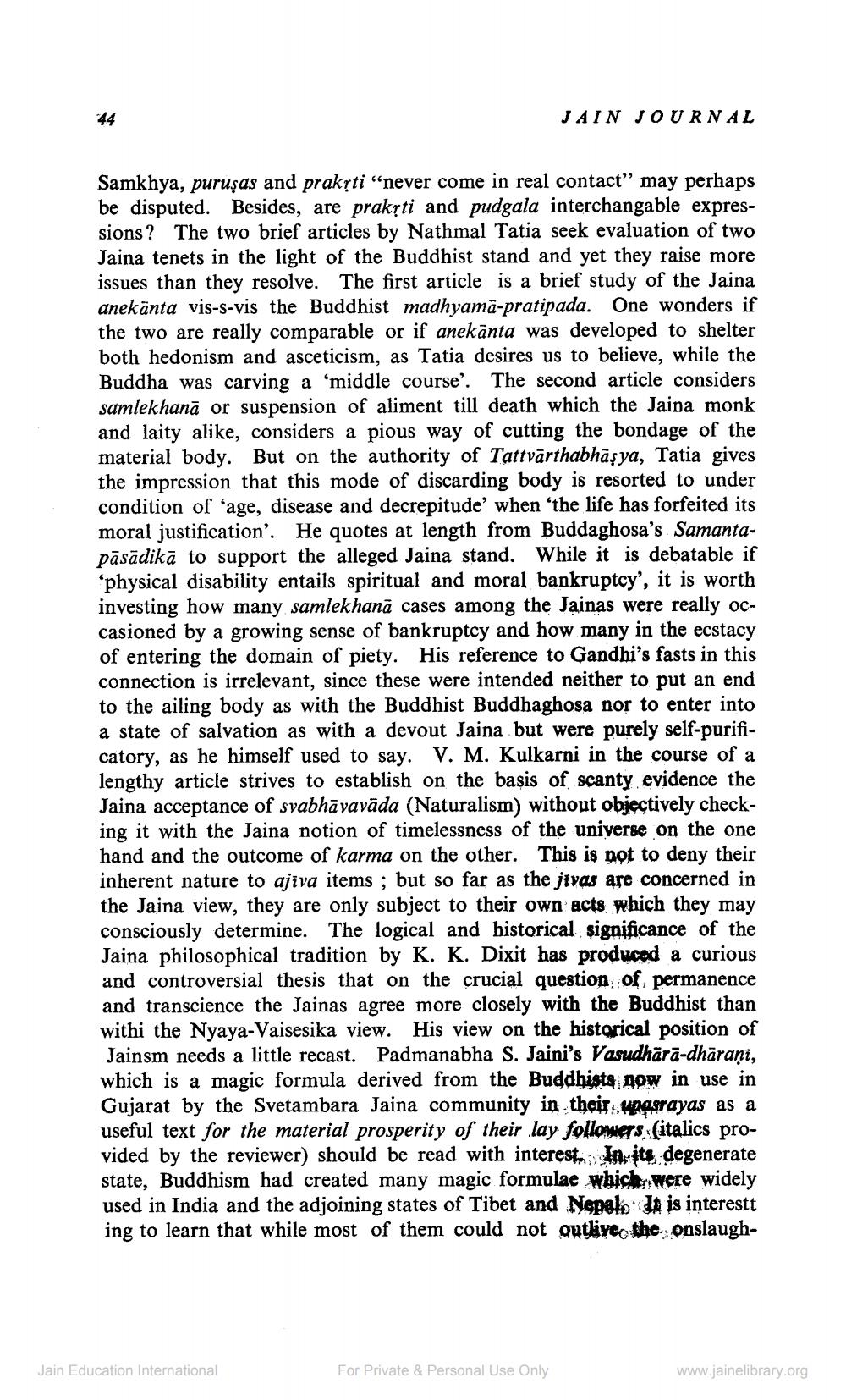Book Title: Jain Journal 1970 07 Author(s): Jain Bhawan Publication Publisher: Jain Bhawan Publication View full book textPage 9
________________ JAIN JOURNAL Samkhya, puruşas and praksti “never come in real contact" may perhaps be disputed. Besides, are praksti and pudgala interchangable expressions? The two brief articles by Nathmal Tatia seek evaluation of two Jaina tenets in the light of the Buddhist stand and yet they raise more issues than they resolve. The first article is a brief study of the Jaina anekānta vis-s-vis the Buddhist madhyamā-pratipada. One wonders if the two are really comparable or if anekānta was developed to shelter both hedonism and asceticism, as Tatia desires us to believe, while the Buddha was carving a 'middle course'. The second article considers samlekhanā or suspension of aliment till death which the Jaina monk and laity alike, considers a pious way of cutting the bondage of the material body. But on the authority of Tattvārthabhāşya, Tatia gives the impression that this mode of discarding body is resorted to under condition of age, disease and decrepitude' when the life has forfeited its moral justification'. He quotes at length from Buddaghosa's Samantapāsādikā to support the alleged Jaina stand. While it is debatable if physical disability entails spiritual and moral bankruptcy', it is worth investing how many samlekhanā cases among the Jainas were really occasioned by a growing sense of bankruptcy and how many in the ecstacy of entering the domain of piety. His reference to Gandhi's fasts in this connection is irrelevant, since these were intended neither to put an end to the ailing body as with the Buddhist Buddhaghosa nor to enter into a state of salvation as with a devout Jaina but were purely self-purificatory, as he himself used to say. V. M. Kulkarni in the course of a lengthy article strives to establish on the basis of scanty evidence the Jaina acceptance of syabhāvavāda (Naturalism) without objectively checking it with the Jaina notion of timelessness of the universe on the one hand and the outcome of karma on the other. This is not to deny their inherent nature to ajīva items; but so far as the jivas are concerned in the Jaina view, they are only subject to their own acts which they may consciously determine. The logical and historical significance of the Jaina philosophical tradition by K. K. Dixit has produced a curious and controversial thesis that on the crucial question of permanence and transcience the Jainas agree more closely with the Buddhist than withi the Nyaya-Vaisesika view. His view on the historical position of Jainsm needs a little recast. Padmanabha S. Jaini's Vasudhārā-dharani, which is a magic formula derived from the Buddhiste now in use in Gujarat by the Svetambara Jaina community in their wpasrayas as a useful text for the material prosperity of their lay followers (italics provided by the reviewer) should be read with interest In-its degenerate state, Buddhism had created many magic formulae which were widely used in India and the adjoining states of Tibet and Nepal is interestt ing to learn that while most of them could not gutlivec the onslaugh Jain Education International For Private & Personal Use Only www.jainelibrary.orgPage Navigation
1 ... 7 8 9 10 11 12 13 14 15 16 17 18 19 20 21 22 23 24 25 26 27 28 29 30 31 32 33 34 35 36 37 38 39 40 41 42 43 44 45 46 47 48 49 50
